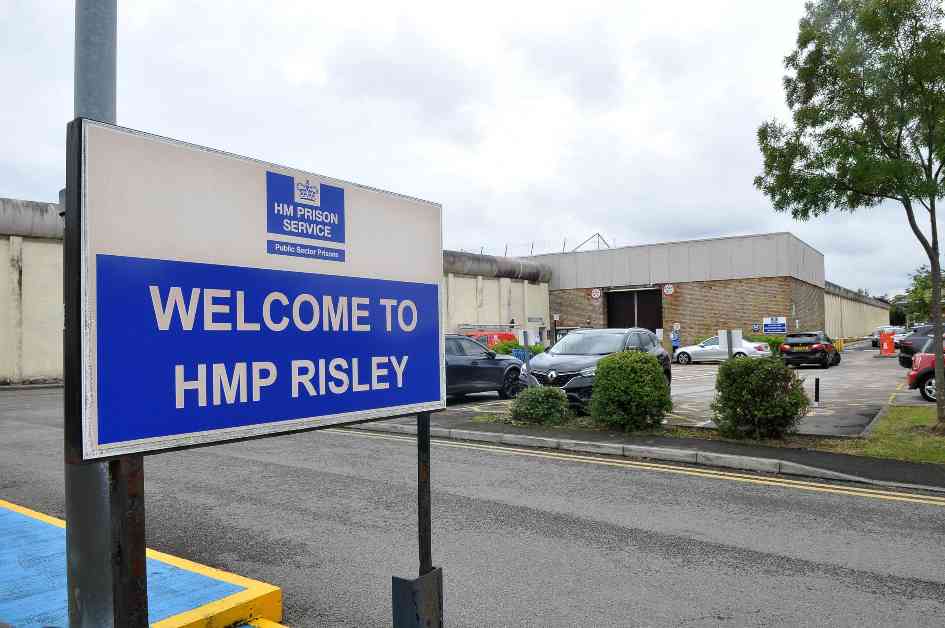Reckless Prisoner Causes Fire in Warrington Jail, Faces Extended Sentence
A reckless prisoner in a Warrington jail has found himself facing an extended sentence after causing a fire at HM Prison Risley. Anthony Eastham, a 31-year-old inmate, made the ill-fated decision to set a blaze within the confines of the prison, resulting in extensive damages. The incident, which occurred on December 15th of last year, led to Eastham being charged with arson and subsequently standing trial at Chester Magistrates’ Court.
During the court proceedings, Eastham opted to change his plea to guilty, leading to a swift sentencing. The details of the case were presented by Chris Howard, the prosecutor, who elaborated on the events that transpired within the prison walls. Eastham’s reckless actions resulted in £3,452.21 worth of damage, a cost that would not go unnoticed during the sentencing process.
Through his guilty plea, Eastham admitted to intentionally setting the fire with the aim of causing damage, or at the very least, being reckless as to whether property would be harmed. Magistrates overseeing the case emphasized the severity of the offense, deeming it significant enough to warrant a custodial sentence. Given the circumstances in which the reckless act took place – within a prison where Eastham was already serving time – the decision was made to impose an immediate, non-suspended sentence.
Eastham, whose address on court documents was listed as HMP Risley, was handed an additional 20 weeks in prison as part of his sentence. Additionally, he was ordered to pay £200 in compensation, a small token towards the damages incurred as a result of his actions.
Impact of Reckless Behavior in Prison Facilities
The incident involving Anthony Eastham sheds light on the consequences of reckless behavior within prison facilities. Not only did his actions result in significant financial damages, but they also posed a serious threat to the safety and security of both inmates and staff members. Fires in correctional institutions can quickly escalate, putting lives at risk and causing widespread destruction.
In addition to the immediate dangers posed by fires, such incidents can also have lasting effects on the mental and emotional well-being of those involved. Inmates who witness or are victims of such events may experience heightened levels of anxiety, fear, and trauma. Staff members tasked with managing these situations are also placed in harm’s way, having to navigate potentially dangerous environments to ensure the safety of all individuals within the facility.
The financial burden of repairing damages caused by fires in prisons is another significant aspect to consider. Resources that could have been allocated towards rehabilitation programs, educational initiatives, or mental health services may instead need to be redirected to cover the costs of repairs. This diversion of resources can have a ripple effect, impacting the overall functioning and effectiveness of the prison system.
Addressing Reckless Behavior in Correctional Facilities
The case of Anthony Eastham underscores the importance of addressing reckless behavior within correctional facilities proactively. Inmates must be held accountable for their actions, especially when they pose a threat to the safety and well-being of others. While rehabilitation and support services are crucial components of the prison system, consequences for reckless or harmful behavior must also be clear and enforceable.
One strategy for addressing reckless behavior in prisons is through the implementation of comprehensive risk assessment and management protocols. By identifying individuals who may be prone to engaging in dangerous or harmful actions, staff members can intervene early to prevent incidents from occurring. This proactive approach not only enhances the safety of the facility but also provides opportunities for targeted interventions and support for at-risk individuals.
In addition to risk assessment and management, education and awareness initiatives can also play a vital role in addressing reckless behavior in prisons. Providing inmates with information on the consequences of their actions, as well as the potential impact on themselves and others, can help deter impulsive or harmful behaviors. By fostering a culture of accountability and responsibility, correctional facilities can create an environment that promotes positive decision-making and reduces the likelihood of incidents like the one involving Anthony Eastham.
Conclusion
The case of Anthony Eastham serves as a stark reminder of the repercussions of reckless behavior within correctional facilities. His decision to set a fire in HM Prison Risley not only resulted in significant damages but also led to an extended sentence and further consequences. By addressing reckless behavior proactively, implementing risk assessment protocols, and fostering a culture of accountability, prisons can work towards creating safer and more secure environments for both inmates and staff members.
As the criminal justice system continues to evolve, it is essential to prioritize the safety and well-being of all individuals within correctional facilities. By holding individuals accountable for their actions and providing support and interventions where needed, prisons can strive towards rehabilitation and positive outcomes for those in their care. The case of Anthony Eastham serves as a cautionary tale, highlighting the importance of addressing reckless behavior before it escalates into more serious incidents.




















